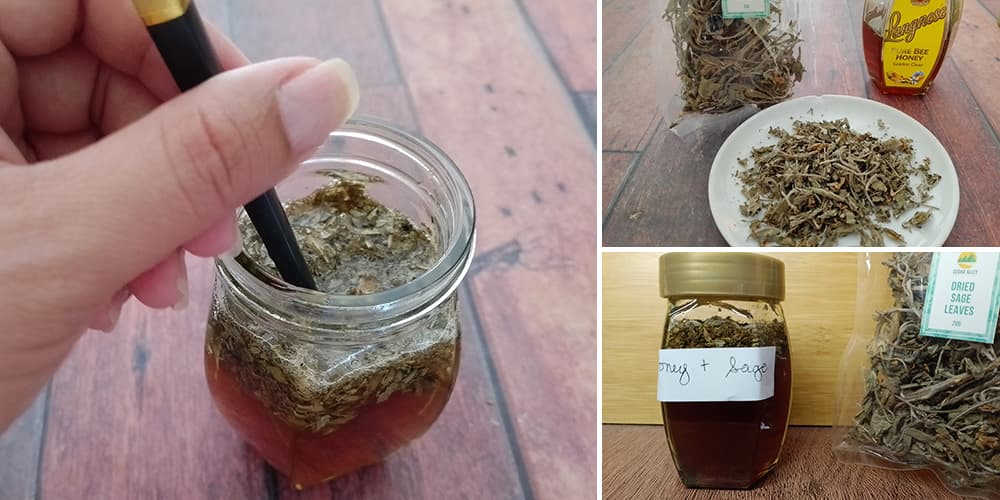
Honey + Sage
One of the best herbs to infuse with honey is sage, which produces an excellent remedy for many health ailments.
Sage (Salvia officinalis), or common sage, is a natural antibacterial herb. Combined with the antiseptic properties of honey, it creates a natural powerhouse.
There are many things to do with sage-honey as a remedy, food, drink, or culinary ingredient. So, let’s get started!
What Sage Does for Your Health
Sage is an aromatic herb occasionally used as a garnish in many dishes. It is rarely eaten raw because of its slightly bitter taste and fuzzy feel. But when cooked, sage goes well with various meat dishes. It also tastes much better when infused and mixed with honey.
Dried and ground sage are popular when it comes to herbal remedies. It is valued in medicine with its medicinal properties that are helpful against the following:
Excessive Sweating: If you have an excessive sweating problem, sage is a wonderful herb for alleviating the condition. It is an excellent antiperspirant and antihidrotic herb that regulates the functions of the sweat glands. Ultimately, intake of sage may reduce other problems related to sweating such as body odor and acne.
Cancer and Chronic Illnesses: Sage contains about 160 polyphenols and compounds, making it an excellent antioxidant. It prevents oxidation and flushes harmful free radicals to lower the risk of cancer and cardiovascular diseases. As an antioxidant, sage may also slow down aging and prevent other chronic diseases.
Mouth Problems: An infusion of sage leaves can kill germs and inhibit their growth, which is useful in supporting gum and mouth health. That is why sage is also used as an ingredient in mouthwash because it can effectively kill the bacteria that cause dental plaque and cavities. Gargling sage infusion is also effective in warding off bad breath.
Anxiety and Depression: Anxiolytic herbs such as sage display excellent ability in reducing stress. Oral intake of sage can affect the nervous system and increase the production of GABA (Gamma-aminobutyric acid) to lessen stress and anxiety. Sage is also an excellent sedative that induces deep and restful sleep to deal with insomnia and restlessness.
Memory and Brain Enhancer: Sage may help with age-related brain problems like memory loss. Its chemical compounds are seen to delay the onset of memory degeneration in conditions like Alzheimer’s Disease. Sage can boost the brain’s defense system and slow down the breakdown of chemical messengers responsible for memory retention.
Improve Digestion: Sage is one of the traditional herbs that is used in managing digestive problems. Preparing a warm infusion of sage and taking it once a day may improve the digestive process and soothe any discomfort. Sage is an effective stomachic and carminative that also helps with gastrointestinal problems. It is also used as an herbal treatment for dysentery.
Decongestant: Sage and honey are an effective home remedy against nasal congestion and respiratory issues. It can ease the inflammation in the respiratory tract to relieve congestion and loosen phlegm. Sage can alleviate nausea, dry mouth and headache that comes with it.
Support Women’s Reproductive Health: Sage is not only useful in treating night sweats and hot flashes. It can also be used to deal with all the problems relating to menopausal and menstrual problems. It can treat estrogen deficiency and stimulate the menstrual flow.
Prevents Complications of Diabetes: Sage-honey contains flavonoids and phenolic acid. Consuming it in moderation can protect the cells from damage, especially those with Type 2 diabetes. However, diabetics need to watch out for the amount of intake of sage-honey. Honey can still cause a spike in blood sugar, so make sure to limit its consumption.
Treat Yeast Infection: Sage is a potent antifungal that can stop the growth of yeast such as in candidiasis. It can also help athlete’s foot caused by dermatophytes. You can take sage-honey internally or apply it topically on the affected area to inhibit the infection from spreading.
⇒ Why Should You Pour Honey Over Jalapenos? (Video)
Honey + Sage Recipe
If you want delicious and aromatic honey, sage-infused honey is a good recipe to try. You can use fresh sage if you like or some dried ones which are available year-round.
Dried sage still retains much of its flavor although it lends an earthy tone more than the floral notes of the fresh ones. Dried sage is also more concentrated, so you typically need it in a lesser amount than you would with fresh sage.
With honey, you can use regular honey but it will be much better if raw. Raw honey comes straight from the hive and may contain beneficial ingredients that pasteurization destroys to produce regular honey.
Generally, sage should not be taken in large amounts because it contains thujone. Thujone can lower blood pressure and may worsen seizures in epileptics. It can also cause miscarriage and reduce milk supply and is therefore not advisable for pregnant and breastfeeding women
You need:
- Mason jar or any glass jar with a plastic cover
- Measuring cup
- Stirrer, such as a wooden chopstick
- 2 tbsp dried sage, crumbled
- 1 cup local honey
Steps:
- Crumble and put 2 tbsp of dried sage in the jar.

- Add honey and stir to coat the herbs completely. You can add more honey to the brim if you want. But if you want a more concentrated sage-honey, the proportion is just right.

- Let the sage infuse in honey for at least five days, turning the jar daily to keep the herbs well-coated. You can infuse it longer if you want to achieve a more intense flavor.

- Strain the honey into a clean jar and store it in a cool and dry place. The sage honey will last indefinitely if stored properly.
How to Use Sage-Honey
There are many ways for you to enjoy sage-infused honey whether as a part of a healthy diet or to cure a minor ailment.
For sore throat, take about a spoonful and eat it slowly to cover the mouth and throat well. You can also pour a cup of boiling water over it and drink it as a soothing sage tea.
If you want a more refreshing tea, add cold water and ice cubes over a tablespoonful of the sage-honey. This herbal infusion also adds a floral taste when added to lemonades.
Applying a layer of the sage-honey to minor skin injuries can speed up its healing and prevent any infection.
Sage-infused honey is safe when taken in food amounts.

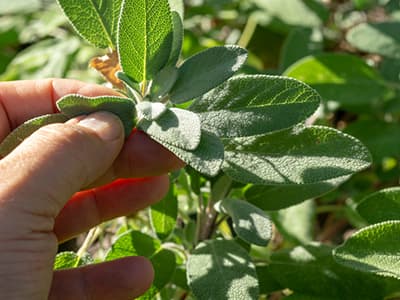
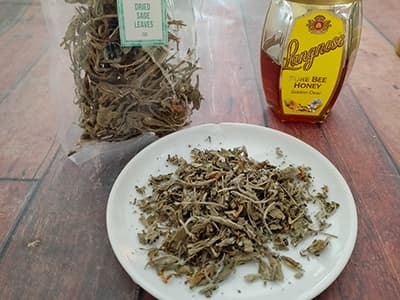
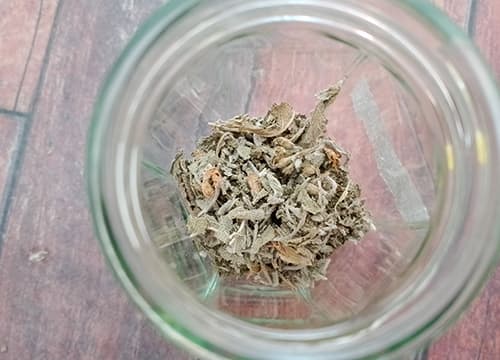
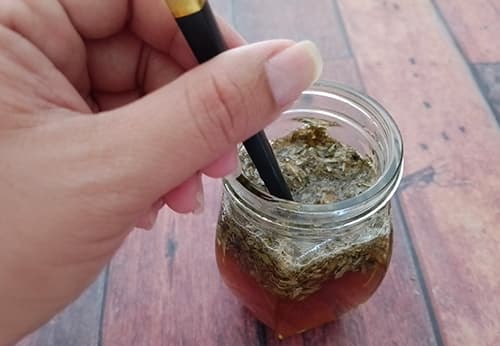
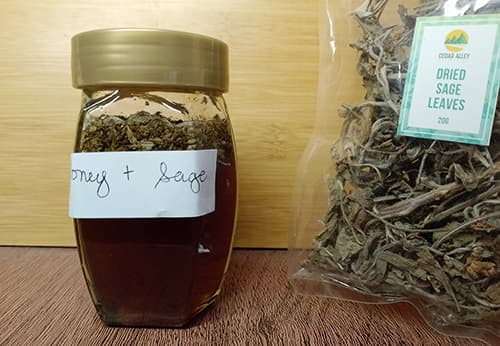
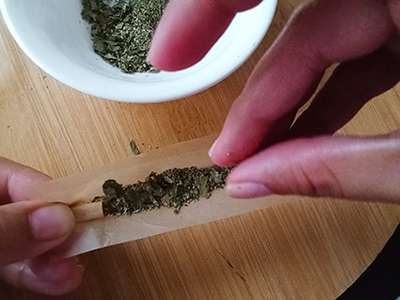
I think I’d order one cost me 50.80 last June. Never received the book. 😢
I would call or write to get the book or a refund! They will make it right.
Maybe they gave you the e-book! That’s what happened to mine! It takes up some memory on my phone, but that’s where it is.
Yes I got a book one but I thought all of them where book I have alot of them on my phone.
Hi Leslie,
Thank you for supporting our work!
Could you please send us an email at support@thelostherbs.com? Our team will make sure to send you all the information you need regarding your order.
Many blessings and good health!
Hi Rebecca,
Thank you for supporting our work! We are sorry to hear that.
Could you please send us an email at support@thelostherbs.com? Our team will make sure to send you all the information you need regarding your order.
Many blessings and good health!
I received the e-book and called the company for th actual book. I received with no problem. At times I use the e-book as well.
The recipe does not give an amount to use if using fresh sage or is this recipe only for dried sage?
Hi Susan,
Thank you for your interest in this recipe!
You can use 6 tablespoons of fresh sage.
Many blessings and good health!
Hi, writing from denmark. How Much honey to the 2 tbsp of sage. And how mutch honey til the recepi? And how much do you take . Thanks ❤️
Hi Pia,
The recipe calls for 1 cup of honey.
You can add a spoonful of strained honey in your teas.
Many blessings and good health!